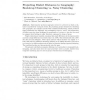Free Online Productivity Tools
i2Speak
i2Symbol
i2OCR
iTex2Img
iWeb2Print
iWeb2Shot
i2Type
iPdf2Split
iPdf2Merge
i2Bopomofo
i2Arabic
i2Style
i2Image
i2PDF
iLatex2Rtf
Sci2ools
GFKL
2007
Springer
2007
Springer
Projecting Dialect Distances to Geography: Bootstrap Clustering vs. Noisy Clustering
Abstract. Dialectometry produces aggregate distance matrices in which a distance is specified for each pair of sites. By projecting groups obtained by clustering onto geography one compares results with traditional dialectology, which produced maps partitioned into implicitly non-overlapping dialect areas. The importance of dialect areas has been challenged by proponents of continua, but they too need to compare their findings to older literature, expressed in terms of areas. Simple clustering is unstable, meaning that small differences in the input matrix can lead to large differences in results (Jain et al. 1999). This is illustrated with a 500site data set from Bulgaria, where input matrices which correlate very highly (r = 0.97) still yield very different clusterings. Kleiweg et al. (2004) introduce composite clustering, in which random noise is added to matrices during repeated clustering. The resulting borders are then projected onto the map. The present contribution compare...
Data Mining | Dialect Areas | Et Al | GFKL 2007 | Kleiweg Et Al |
| Added | 07 Jun 2010 |
| Updated | 07 Jun 2010 |
| Type | Conference |
| Year | 2007 |
| Where | GFKL |
| Authors | John Nerbonne, Peter Kleiweg, Wilbert Heeringa, Franz Manni |
Comments (0)

